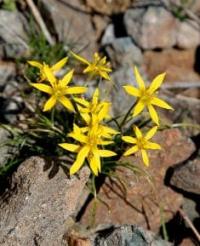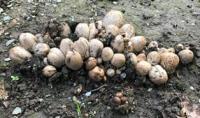You are here
Soils of Kazakh small hills.


Educational travel around Kazakhstan.
“The northern part of the Kazakh small hills belongs to the steppe zone with forb-fescue-feather grass vegetation on southern chernozems, partially plowed; middle - to the dry steppe zone with fescue-feather grass vegetation on dark chestnut (also partly plowed) and chestnut soils. The southern and eastern parts of the Kazakh hillocks are part of a semi-desert zone, where steppe (turf-grass) and desert (wormwood and solyanka) plant communities are combined and light chestnut soils predominate; the southeastern part near Lake Balkhash is part of the desert zone.”
N. A. Gvozdetsky.
Traveling around Central Asia.
In the Kazakh small hills, the soil-forming rocks are represented mainly by eluvium and colluvium of hard bedrock. When granites and sandstones are weathered, light non-saline varieties of soils usually develop; on porphyrites - loamy, gravelly soils; on marls and limestones - loess-like, silty and highly carbonate soils; on clay shales - heavy loamy soils.
The soils of small hills usually have a shortened and incomplete profile, often gravelly and thin. The soil cover is interrupted by bedrock outcrops. The best soils are confined to gentle slopes and depressions between the hills. On the Turgai Plateau, soils develop on fine-earth soils and have a normal profile.
Only in the north, in the Kokchetav province of Central Kazakhstan, are common chernozems widespread, while the main background of the soil cover of the subzone is formed mainly by carbonate southern chernozems, formed under forb fescue and feather grass communities.
They contain from 4 to 7% humus and are characterized by the absence of salinity and alkalinity, which makes them quite suitable for agricultural development. Fescue and feather grass steppes with a predominance of (Stipa lessingiana), Korzhinsky feather grass (S. korshinskyi), (S. capillata), (Festuca sulcata) and xerophytic forbs (Artemisia austriaca, A. dracunculus, Phlomis tuberosa, Salvia stepposa) are developed on these soils. .
Among the southern carbonate chernozems, patches of southern non-carbonate chernozems are found under forbs, feather grass steppe, dominated by red feather grass (Stipa rubens) richer forbs. On river terraces and in depressions between the hills, solonetzic southern chernozems in combination with solonetzes are developed on saline carbonate clays.
The vegetation cover is dominated by sparse and depleted in species composition wormwood and feather grass communities. In the depressions of the lakes, meadow and chernozem soils with a high humus content (8 - 10%) and deep solonetsity are developed.
Typically, meadow or steppe and meadow communities are common here with dominance of (Calamagrostis epigeios), (Agropyron repens), etc. On gravelly and sandy loam soils there are areas of shrub steppe with spirea (Spiraea hypericifolia) and (Caragana frutex).
In the mountain ranges of the Kazakh small hills, altitudinal zonation is manifested. Lots of rocks and scree. The soil cover develops well only in flat areas and is represented by thin mountain chernozems with a high humus content (up to 12%). Such areas are occupied by steppe vegetation Artemisia frigida.
A leafy succulent (Orostachys spinosa) grows in rocky areas. Along the rocks, at the outcrops of crystalline rocks, there are pine forests with dwarf juniper (Juniperus sabina); such forests are widespread in the Kokchetau mountains, and the pine usually has a curved trunk and crown shape. Along the depressions, aspen, birch, bird cherry, viburnum, hawthorn, and raspberry are mixed with pine.
Due to an increase in evaporation and a decrease in precipitation to the south, the subzone of mixed-grass, cereal chernozem steppes passes into the zone of cereal steppes on dark chestnut soils, which is also called the zone of dry steppes.
Compared to the zone of forb grass steppes, the hydrothermal regime of dry steppes is less favorable. Maximum precipitation occurs in May. Then there is a rapid increase in temperatures (the average temperature in July is within the zone of 20 - 24°), accompanied by intense evaporation.
Therefore, already in mid-summer the vegetation begins to burn out. The main background soil cover of this subzone is formed by dark chestnut soils. The humus content in them is about 4%. The soils are not saline and are suitable for agriculture.
In the western part of the subzone, where the soils are formed by carbonate clays, dark chestnut carbonate soils are common. Carbonate varieties have a less favorable water-air regime, although they are also suitable for agriculture. The development of dark chestnut soils is complicated by the fact that they are usually found in combination with dark chestnut brackish soils (in relief depressions).
In the east, the mountain Kyrgyz feather grass (Stipa kirghisorum) appears. In some places, the more xerophytic species (S. sareptana) plays a significant role. Quite abundant are (Koeleria gracilis) and (Helictotrichon desertorum). Forbs are represented by xerophytes (Linosyris villosa, chamomile - Pyrethrum achilleifolium. In spring, ephemerals and ephemeroids develop, mainly (Poa bulbosa) and tulips.
Thickets of steppe shrubs are found along the depressions and gullies. Along the slopes of the hills there are dark chestnut thin soils on which (Artemisia frigida and A. sublessingiana) grow. Areas with such soils are unsuitable for agriculture and are used as pastures and hayfields.
The subzone is characterized by the complexity of the soil and vegetation cover, associated with the distribution of saline soil-forming rocks in the lower relief elements, on which dark chestnut saline soils and steppe soils develop. Saline land spots are rare. On dark chestnut salty soils, peculiar communities with (Artemisia lercheana) develop.
Within the subzone of dry steppes in the Kazakh small hills, the phenomenon is also observed altitudinal zonation. Along the rocky peaks of the low mountains grow pine trees with a grass cover of steppe species. Near groundwater outlets there are aspens and birch groves.
The fauna of the steppe zone includes many rodents: large ground squirrel (Citellus major), large jerboa (Allactaga jaculus), ground hare (Alactagulus acontion), (Scirtopoda telum), (Ellobius talpinus), various (Microtus gregalis), etc. Among the predators there are wolf, fox, badger, weasel, ermine and such typical steppe species as the steppe ferret (Putorius eversmanni) and (Vulpes corsac).
Of the birds, the bustard (Otis tarda) is especially characteristic. On the territory of the Kazakh small hills, due to the presence of low-mountain massifs with pine forests, through which the forest fauna penetrates to the south, a mixture of steppe and forest forms occurs.
The most common forest species is the mountain hare (Clethrionomys rutilis). There are taiga birds - bullfinch, siskin, yellowtail, and black-headed tit. Previously there was a wood grouse here, and among the animals there was a brown bear.
Within the steppe zone of Central Kazakhstan, vast spaces are occupied by soils that are not suitable for plowing without prior reclamation. These are southern carbonate and non-carbonate chernozems, as well as dark chestnut soils. For a long time, large tracts of arable land in Kazakhstan were not used for agriculture.
In 1954, in connection with the decree of the party and government on the development of virgin and fallow lands, large areas were plowed here, which are now occupied by crops of grain crops, primarily spring wheat. Due to the general dryness of the climate, grain farming within the steppe zone of Central Kazakhstan requires the use of agrotechnical measures aimed at accumulating and preserving moisture in the soil.
One of them is snow retention on fields in winter. Soils that are light in mechanical composition, especially dark chestnut soils, are susceptible to deflation, to combat which special measures must be taken. he difficulties of developing the steppe zone are also associated with the complexity and diversity of the soil cover, which are caused by the distribution of solonetzic soils, solonetzes and partly solonchaks, and in the Kazakh small hills also by the presence of gravelly soils and numerous outcrops of bedrock.
Alkaline soils and solonetzes can be used in agriculture only after carrying out costly radical reclamation. Therefore, areas with a predominance of solonetzes are more profitable to use as pastures. In the Kazakh small hills, gravelly and thin varieties of light chestnut soils with sparse plant cover are common on the slopes of the hills.
Even at low elevations of the semi-desert zone, due to an increase in precipitation (up to 250 - 275 mm/year), altitudinal zonation can be traced. Light chestnut soils here are replaced by dark chestnut soils, on which wormwood-feather grass communities appear.
In the semi-desert zone, farming is advisable mainly only with artificial irrigation. Since there are no large waterways that can serve as sources of irrigation, individual irrigated areas exist mainly around the most abundant sources of water. The presence of saline and alkaline soils further complicates the agricultural development of the territories.
Therefore, agriculture is of a focal nature, and most of the territory is used as pasture. Low snow cover makes winter grazing possible. In winter, sheep even eat saltworts, which are inedible in summer due to their high salt content. In summer, grazing is difficult due to poor water availability in the area.
However, some areas, for example, the “steppes” of Sary-Arka (in fact, these are not only steppes, but also semi-deserts) in the south and in the center of the Kazakh hillocks, are used as summer pastures; for the winter, cattle are driven from them through the Betpak-Dala desert to the sands of Moyynkum and the Chui Valley.
As you can see, the semi-desert zone is mainly pasture. Therefore, the northern border of the semi-desert, which serves as the southern limit of rain-fed agriculture, should be identified as the most important natural and economic boundary.
Authority:
N. A. Gvozdetsky, N. I. Mikhailov “Physical Geography of the USSR”, Asian part, Third edition, corrected and expanded, Moscow “Thought” 1978.
Photos by:
Alexander Petrov.







